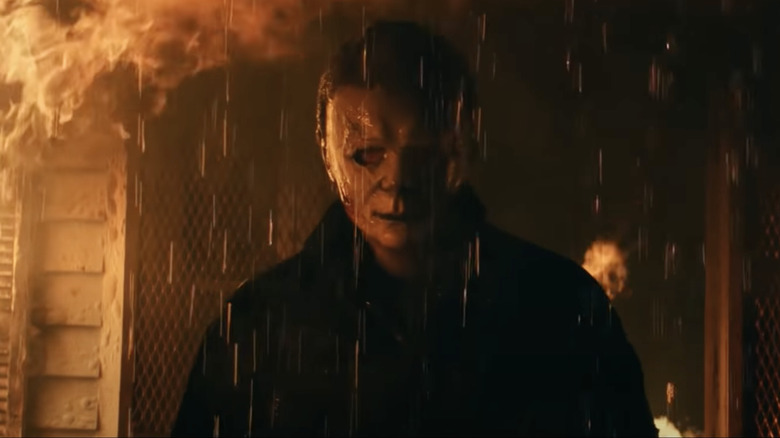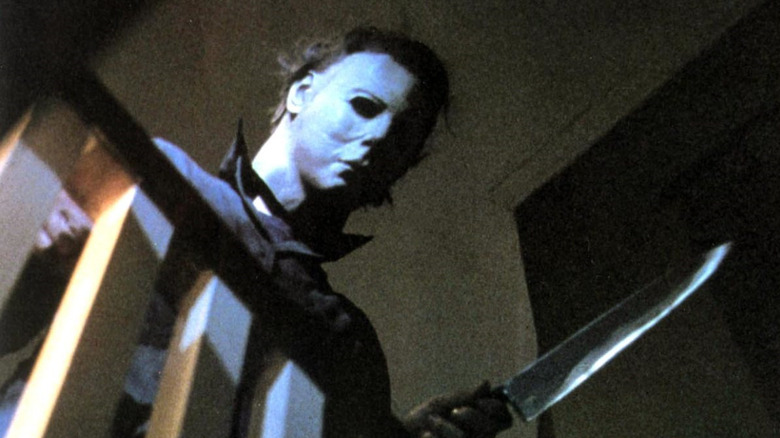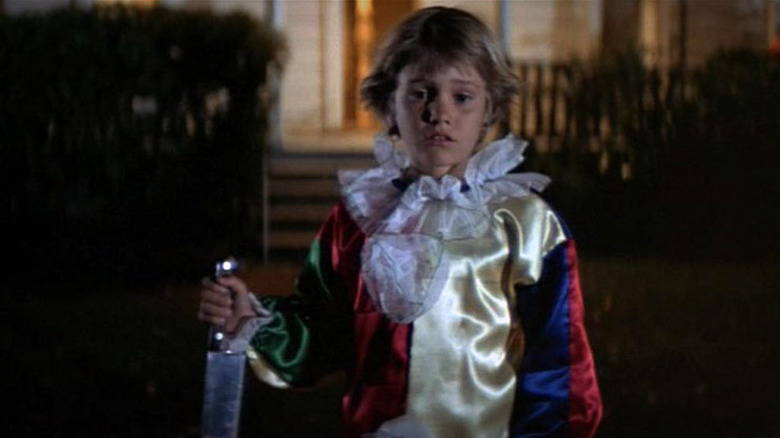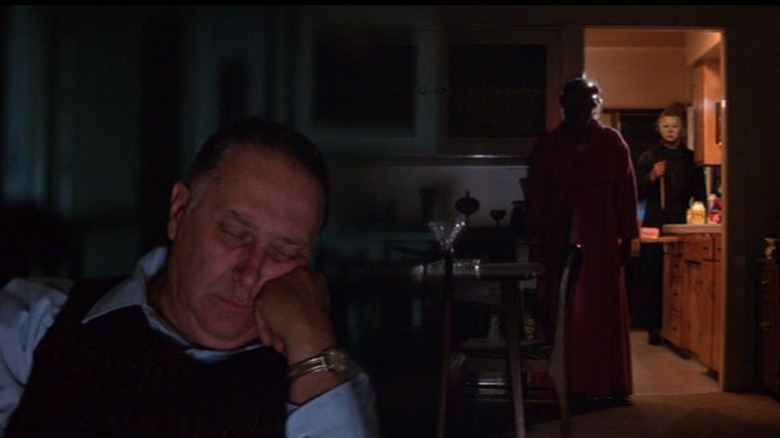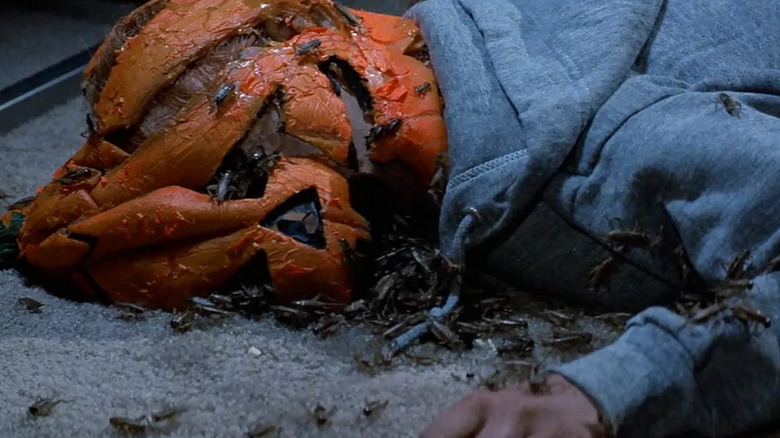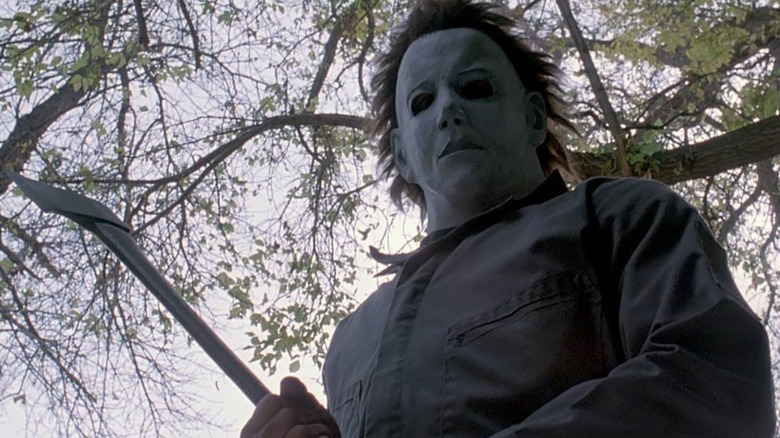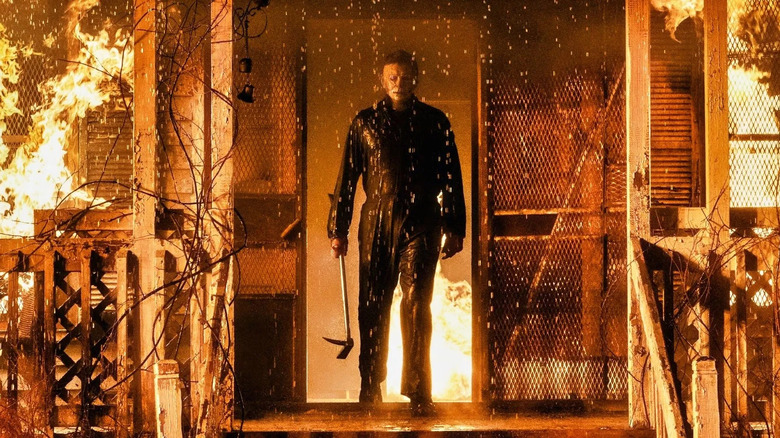Why Michael Myers Is Obsessed With Killing People: An Investigation
With the upcoming "Halloween Ends" promising a finale to David Gordon Green's "H40" revival trilogy (and an end-of-watch relief for franchise veteran Jamie Lee Curtis), this will be the eleventh movie in the "Halloween" franchise, and the tenth featuring its principal killer, the masked psychopath Michael Myers. At the age of six, Michael stabbed his sister to death on Halloween night, went away for a while, and ever since he returned to his hometown of Haddonfield in John Carpenter's "Halloween" in 1978, Michael has been slicing and dicing teens, parents, dogs, shock jocks, and cops in a mindless annual holiday massacre.
What's been his motivation all these years? Other genre titans like Freddy Krueger and Jason Voorhees are mostly revenge-based, but the stimulus that drives Michael to kill can vary, depending on the timeline. Myers is an iteration of evil spawned directly from an experience the "Assault on Precinct 13" director had, with a face so blank that people can project any horror onto it. The pale William Shatner mask he wears covers up any sense of emotion behind its hollowed-out eyes, and he doesn't offer the foul-mouthed monologues that Good Guy Chucky spits forth in his "Child's Play" films and shows. It's up to other characters in the "Halloween" universe, often the world's most unsuccessful psychiatrist Dr. Loomis, to theorize why death comes to Haddonfield every October. They find that it goes deeper than just hating babysitters; from story to story, Myers' compulsion to kill has different flavors to it. Here's a look at what grinds Michael's gears.
Night Moves
When he co-wrote the seminal slasher "Halloween" with producer Debra Hill, John Carpenter didn't intend to keep Michael Myers' coverall-covered corpse coming back for sequel after sequel in a sort of box-office necromancy. In Jason Zinoman's industry chronicle "Shock Value," the famously blunt Carpenter is quoted thusly:
"They want me to do the same movie again. No. There's no more story. Sorry. It's over. It was over when I finished with the first one. There's nothing left to say. Michael goes away and he comes back and kills someone. Oh, please. Stop! Stop! Stop! Stop! Stop!"
The first and most popular film in the entire series, in his defense, is pretty contained. Following his escape from a sanitarium, Myers returns to the place where he killed his sister years before and glimpses Laurie Strode (Curtis), who reminds him of said slain sister, Judith. For the rest of the movie, he stalks her and her friends, dispatching them one by one until Laurie – the only one to stab him back – is saved by Dr. Loomis (Donald Pleasence), the beleaguered Ahab to Myers' white whale.
But the thing about evil is that it doesn't die, especially when there are sequels and tie-ins to be made. That's the reason for so many horror franchises that build upon a wildly successful original: the Wes Craven-Kevin Williamson-spawned "Scream" movies recently enjoyed the fifth entry and are gearing up for a sixth round with the Ghostface du jour, and a new, eleventh "Hellraiser" conjures up sadism and style with a rebooted adaptation of Clive Barker's novella "The Hellbound Heart." This isn't a cynical take. Imitation is one of the horror genre's longest-running traditions, and sometimes its stories can evolve for the better.
Turn the Page
Tie-in movie novelizations enjoy a special creative place, both beholden to the major events of the film they extend from and free to play fast and loose with backstory. In Curtis Richards' 1979 novelization of Carpenter's smash hit, Michael is presented as a cog in a long-running mechanism of the holiday spirit itself.
The prologue begins the Myers/Strode saga centuries before 1978, on a foggy Irish night – the eve of the Druid festival Samhain, from whence so many Halloween traditions came. Curtis describes the daughter of a Druid king and the deformed young man who killed slaughtered her and her betrothed when she rejected the teen's advance. At the grieving king's request, a shaman cursed the murderer to "roam the earth till the end of time, reliving thy foul deed and thy foul punishment." Samhain mutated over time by early Christian influence, a shell of the once spiritually-reverent celebration that it was. Curtis goes on:
"Except that from time to time, the innocent frolic of All Hallow Even was shattered by some brutal and inexplicable crime, and the original holiday spirit of the celebration was brought home to a horrified world."
That societal disruption, Curtis writes, was passed down from village to village, clan to clan, and made its way into the Myers family. Michael's mother and grandmother talk in hushed tones about young Michael's issues: late-stage bedwetting, fights at school and at home, and influential voices in his head. These voices might be hereditary; grandma cites a "Grandpa Nordstrom" who also heard voices, and acted upon them with tragic results. It's little hinted at in the movie, but in the book, Michael is a pawn in an ancient game.
The Fire Down Below
"Halloween II" began a series of complicated explanations for Michael's evil and his obsession with specific targets like Laurie, usually leaving fans with more questions than answers. In Rick Rosenthal's 1981 follow-up, Laurie Strode struggles to know why she was targeted, and the answer, according to Carpenter and Hill's script, is that she is actually his biological sister. That's why Michael followed her to Haddonfield Memorial Hospital; he was repeating history.
In Murray Leeder's study of "Halloween," Carpenter describes the sibling revelation as "purely as a function of having decided to become involved in the sequel to the movie where I didn't think there was really much of a story left." What was once an unknowable abomination, nearly Eldritch in his impenetrability, now began to take on the features of something more mortal, a monster that could be understood.
Carpenter has been vocal about his disdain for Rosenthal's follow-up and the sibling backstory he co-wrote, but the family connection went on to act as motivational source material for the next several sequels. The family ties would be severed with David Gordon Green's 2018 installment "Halloween," which shouldn't be confused with the original Carpenter film "Halloween," which is a direct sequel. Nor should that be mixed up with "Halloween," Rob Zombie's 2007 remake of the 1978 film. Green's nu-"Halloween" discarded that canon as well as all of the 1988-1995 explanations like a psychic-mute niece, magic runes, an incest baby, and Paul Rudd. He hung onto the sequel canon but ultimately decided that the randomness of the killings gave them more power. Michael went up in flames by the time "Mr. Sandman" began playing over the end credits, so the next "Halloween" story would have to get creative.
The one without Michael
"Halloween III: Season of the Witch" has no Michael Myers to account for, which is what its creators wanted. Carpenter and Hill had originally plotted an anthology franchise, each sequel self-contained with a unique story and fresh characters. This one would leave behind the slasher structure and lean more into witchcraft, observing a doctor as he investigates a shady Halloween mask manufacturer. According to star Tom Atkins, studio execs insisted on the "Halloween" title despite the lack of Myers, conceding the "Season of the Witch" subtitle to differentiate it from its predecessors. Despite a $14.4 million box-office gross upon its release in 1982, "Season of the Witch" was the poorest-performing franchise entry to date and all but handed its creators the scissors to sever themselves from the franchise.
Once maligned as the black sheep of the franchise, the third film has since earned goodwill in light of, well, all of the sequels that did feature Michael Myers and had the audacity to be bad anyway. Sometime since the late 90s run of Dimension Films-helmed sequels, "Season of the Witch" has enjoyed re-evaluation, with many looking back favorably on the witchy installment. /Film's Chris Evangelista hails it as the best Halloween sequel, citing its unapologetic grimness. "There's no sense of safety here," Evangelista writes, "no sense that once the sun rises and Halloween ends, things will be alright."
By the time Michael stepped back into the coveralls and picked up the butcher knife for one last scare, his movements would be pre-ordained by something greater.
The Thorn Trilogy
"The Return of Michael Myers" is the first of the Thorn trilogy, so named for the ancient curse that pulls the killer's strings. During a sanitarium transfer, Myers awakens from a coma with that old autumn urge to terrorize a girl. Upon hearing that Laurie Strode had a daughter, the titan cuts through a swath of first responders, mechanics, boyfriends, rednecks, and cops to get to her, and when their hands touch, some of that classic Samhain spirit rubs off on young Jamie (Danielle Harris), who is in turn compelled to do some bloodletting of her own. Alan B. McElroy's screenplay was a rush job; due to the impending 1988 Writers Guild of America strike, McElroy had eleven days to pitch, write, and submit a finished draft. The story kills off Laurie Strode without fanfare, and gives Myers a new family member to hunt down as he did in "Halloween II."
Jamie shares a psychic connection with her uncle, whom she has frequent nightmares about until they finally meet face-to-face. In "Halloween 5: The Revenge of Michael Myers," released just a year after the fourth film, Jamie's nightmares give way to seizures and traumatic muteness. Loomis has the bright, unethical idea of using the girl as a sort of homing beacon to draw the killer near, and it works, but killing him isn't so easy. What "5" begins, "The Curse of Michael Myers" would see through to its conclusion; a mysterious Man in Black turns out to be a steward for Michael, getting him out of jams and enabling him to eliminate his bloodline on behalf of a Druid cult that controls him with magic runes, causing weary fans everywhere to wonder aloud why he can't simply be a psychotic man with a knife.
Pure evil doesn't needs a backstory
The rest of the "Halloween" movies keep things relatively simple. "Halloween: H20" brings back fan favorite Jamie Lee Curtis to reprise her role as Laurie Strode — references to Myers' telepathic niece Jamie are discarded as well as the Thorny lore of the previous entries. The death of Donald Pleasence in 1995 ended the run of Dr. Loomis until Malcolm McDowell stepped into the character's rumpled trench coat for Rob Zombie's "Halloween," but subsequent movies didn't need anyone to exposit what filmmakers and fans wanted: an unstoppable killing machine who didn't need to be pathologized.
Myers kills in "H20" because he found out Laurie is alive and came looking for the One that Got Away, resulting in their first face-to-face reunion in twenty years. Four years later, he would kill again in the franchise's most diminished return, "Halloween: Resurrection," because a bunch of vloggers were traipsing around in his childhood house.
Rob Zombie's vision of Myers struck close to the brute created by Carpenter and Hill, with McDowell's Loomis categorizing him thusly:
"Inside every one us, there exists a dark side. Most people rise above it, but some are consumed by it. Until there is nothing left, but pure evil."
For Zombie in the aughts and David Gordon Green from 2018 to present, the slasher icon has no sibling connection, no sinister cabal commanding him, nothing but the blackest eyes behind that deteriorating white mask — "like a doll's eyes," the original Loomis would say. As fun as those middle sequels can be, there's something singular and terrifying about a great white shark of a killer who never eats, never sleeps, and never stops until his blade meets as much flesh as possible.
